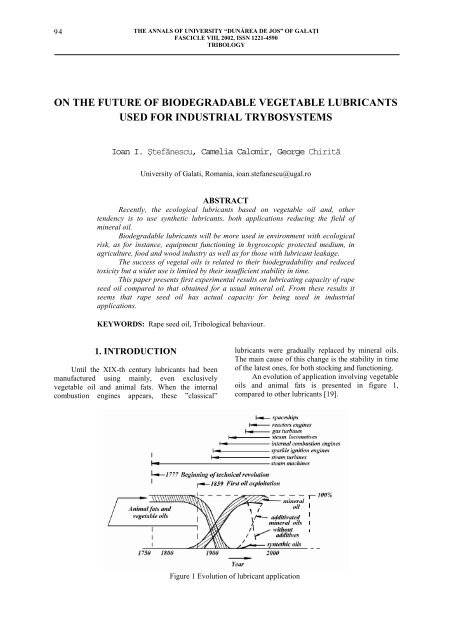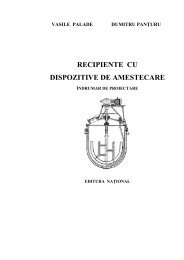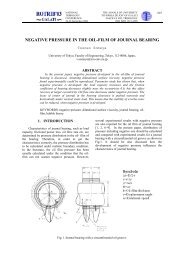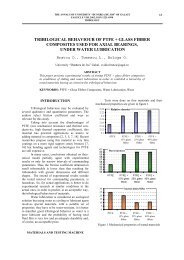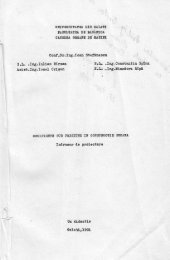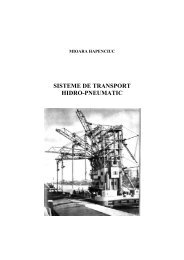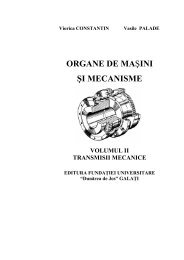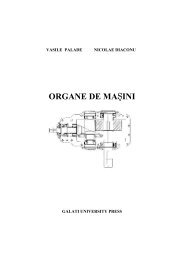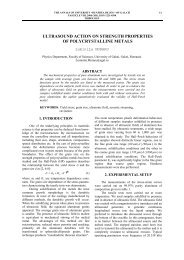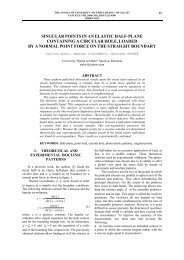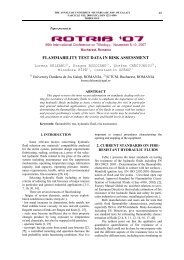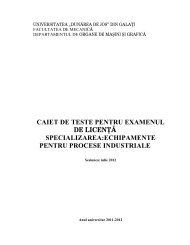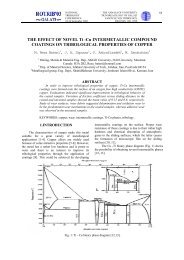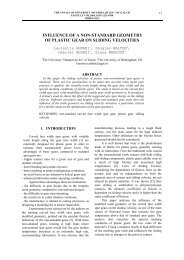on the future of biodegradable vegetable lubricants - Dunarea de Jos
on the future of biodegradable vegetable lubricants - Dunarea de Jos
on the future of biodegradable vegetable lubricants - Dunarea de Jos
Create successful ePaper yourself
Turn your PDF publications into a flip-book with our unique Google optimized e-Paper software.
94<br />
THE ANNALS OF UNIVERSITY “DUNĂREA DE JOS” OF GALAŢI<br />
FASCICLE VIII, 2002, ISSN 1221-4590<br />
TRIBOLOGY<br />
ON THE FUTURE OF BIODEGRADABLE VEGETABLE LUBRICANTS<br />
USED FOR INDUSTRIAL TRYBOSYSTEMS<br />
Ioan I. Ştefănescu, Camelia Calomir, George Chirită<br />
University <strong>of</strong> Galati, Romania, ioan.stefanescu@ugal.ro<br />
ABSTRACT<br />
Recently, <strong>the</strong> ecological <strong>lubricants</strong> based <strong>on</strong> <strong>vegetable</strong> oil and, o<strong>the</strong>r<br />
ten<strong>de</strong>ncy is to use syn<strong>the</strong>tic <strong>lubricants</strong>, both applicati<strong>on</strong>s reducing <strong>the</strong> field <strong>of</strong><br />
mineral oil.<br />
Bio<strong>de</strong>gradable <strong>lubricants</strong> will be more used in envir<strong>on</strong>ment with ecological<br />
risk, as for instance, equipment functi<strong>on</strong>ing in hygroscopic protected medium, in<br />
agriculture, food and wood industry as well as for those with lubricant leakage.<br />
The success <strong>of</strong> vegetal oils is related to <strong>the</strong>ir bio<strong>de</strong>gradability and reduced<br />
toxicity but a wi<strong>de</strong>r use is limited by <strong>the</strong>ir insufficient stability in time.<br />
This paper presents first experimental results <strong>on</strong> lubricating capacity <strong>of</strong> rape<br />
seed oil compared to that obtained for a usual mineral oil. From <strong>the</strong>se results it<br />
seems that rape seed oil has actual capacity for being used in industrial<br />
applicati<strong>on</strong>s.<br />
KEYWORDS: Rape seed oil, Tribological behaviour.<br />
1. INTRODUCTION<br />
Until <strong>the</strong> XIX-th century <strong>lubricants</strong> had been<br />
manufactured using mainly, even exclusively<br />
<strong>vegetable</strong> oil and animal fats. When <strong>the</strong> internal<br />
combusti<strong>on</strong> engines appears, <strong>the</strong>se ”classical”<br />
<strong>lubricants</strong> were gradually replaced by mineral oils.<br />
The main cause <strong>of</strong> this change is <strong>the</strong> stability in time<br />
<strong>of</strong> <strong>the</strong> latest <strong>on</strong>es, for both stocking and functi<strong>on</strong>ing.<br />
An evoluti<strong>on</strong> <strong>of</strong> applicati<strong>on</strong> involving <strong>vegetable</strong><br />
oils and animal fats is presented in figure 1,<br />
compared to o<strong>the</strong>r <strong>lubricants</strong> [19].<br />
Figure 1 Evoluti<strong>on</strong> <strong>of</strong> lubricant applicati<strong>on</strong>
THE ANNALS OF UNIVERSITY “DUNĂREA DE JOS” OF GALAŢI<br />
FASCICLE VIII, 2002, ISSN 1221-4590<br />
TRIBOLOGY<br />
95<br />
In <strong>the</strong> last 15 years, <strong>the</strong> research for<br />
manufacturing new products being neutral as<br />
c<strong>on</strong>cerning <strong>the</strong>ir influence <strong>on</strong> <strong>the</strong> envir<strong>on</strong>ment makes<br />
<strong>the</strong> <strong>vegetable</strong> oils attractive again for lubricating<br />
purpose.<br />
Classical examples <strong>of</strong> using rape seed oil are<br />
hydraulic <strong>de</strong>vices and chain and saw lubricati<strong>on</strong>, etc.<br />
[6], [8], [9], [11], [15], [16].<br />
At presents, <strong>the</strong> success <strong>of</strong> <strong>the</strong> <strong>vegetable</strong> oils<br />
may be explained by characteristics <strong>of</strong> actual interest:<br />
bio<strong>de</strong>gradability and low toxicity. In Germany,<br />
introducti<strong>on</strong> <strong>of</strong> <strong>the</strong>se oils is sustained by<br />
governmental institutes [1].<br />
A larger use <strong>of</strong> <strong>vegetable</strong> oils is restricted due to<br />
<strong>the</strong>ir insufficient stability in time (<strong>the</strong>y age more<br />
quickly than <strong>the</strong> mineral oils) and even in functi<strong>on</strong>ing<br />
if <strong>the</strong> <strong>the</strong>rmal field exceeds critical limits usually<br />
lower that those characterising <strong>the</strong> mineral oils.<br />
It is estimated that from total quantity <strong>of</strong><br />
<strong>lubricants</strong>, ~85% is represented by products<br />
c<strong>on</strong>taining mainly mineral oils. The remaining 15 %<br />
is c<strong>on</strong>si<strong>de</strong>red to be products with <strong>vegetable</strong> and<br />
expensive syn<strong>the</strong>tic oils. The actual use <strong>of</strong> <strong>vegetable</strong><br />
oils <strong>on</strong> lubricant market was un<strong>de</strong>r 0.5% in European<br />
Community.<br />
Bio<strong>de</strong>gradable <strong>lubricants</strong> will be more<br />
intensively used in envir<strong>on</strong>ment with ecological risk,<br />
especially for protected areas or food and light<br />
industry and when lubricant leakage could not be<br />
entirely eliminated.<br />
2. BASIC MATERIALS FOR NATURAL<br />
LUBRICANTS<br />
Basic materials for obtaining <strong>the</strong> natural<br />
<strong>lubricants</strong> have <strong>vegetable</strong> and animal character.<br />
Natural oils and fats is a supply <strong>of</strong> basic<br />
materials that, by hydrogenati<strong>on</strong> or dissociati<strong>on</strong><br />
reacti<strong>on</strong> may give intermediate products that may<br />
combine, resulting complex esters and polyesters and,<br />
finally, <strong>the</strong> basic oil <strong>of</strong> a good lubricant. (figure 2) [1].<br />
Animal oils and fats are obtained from pork,<br />
sheep and cow fats and are used for lubricating fine<br />
mechanisms and for manufacturing c<strong>on</strong>sistent<br />
greases. This group inclu<strong>de</strong>s b<strong>on</strong>es and ho<strong>of</strong>s oil, seal<br />
fats, oil extracted from whale brain and spinal cord,<br />
suet, pork fat, b<strong>on</strong>e fat, stearine and olein, fish oil and<br />
woollen fat.<br />
Basic material <strong>of</strong> <strong>vegetable</strong> origin are obtained<br />
from oleaginous plants: sunflower, soy been, rape<br />
seed, castor, cott<strong>on</strong> and in <strong>the</strong> tropical z<strong>on</strong>e, from<br />
palms, coc<strong>on</strong>ut tree, olive, nuts.<br />
Basic natural oils<br />
Figure 2 Basic natural oils<br />
In Romania <strong>the</strong> oil plants <strong>of</strong> most interest are,<br />
sunflower, castor, rape, soy been, cott<strong>on</strong>.<br />
From analytic and ec<strong>on</strong>omic reas<strong>on</strong>, <strong>the</strong> rape<br />
seed oil are <strong>the</strong> most important as lubricant.<br />
Therefore, <strong>the</strong> <strong>lubricants</strong> based <strong>on</strong> rape seed oil are<br />
used in hydraulic power transmissi<strong>on</strong> and in<br />
lubricating cutting raw.<br />
3. STRUCTURE, COMPOSITION AND<br />
PROPERTIES OF VEGETABLE OILS<br />
Generally, all refined <strong>vegetable</strong> oils by <strong>the</strong> help<br />
<strong>of</strong> alkalis have more than 99% threeglicery<strong>de</strong>s, except<br />
few <strong>on</strong>es obtained from exotic plants. Threeglyceri<strong>de</strong>s<br />
are esters <strong>of</strong> fat acids. Fat acids (with or without<br />
double link) may be classified as following [7]:<br />
- saturated (without double link): myristic,<br />
palmitic, stearic;<br />
-m<strong>on</strong>o-n<strong>on</strong>-saturated (with <strong>on</strong>ly <strong>on</strong>e double<br />
link): oleic, erucic;<br />
-poly-n<strong>on</strong>-saturated (with more than <strong>on</strong>e<br />
double link): linoleic, linolenic;<br />
-special (c<strong>on</strong>tains o<strong>the</strong>r groups as hydroxyl in<br />
ricin oleic and epoxy in vernolic).<br />
By combining <strong>the</strong> fat acids and <strong>the</strong> glycerine, a<br />
large diversity <strong>of</strong> complex esters is obtained. Such a<br />
complex glycerine esters are <strong>the</strong> groups: β-CH and<br />
ester. If <strong>the</strong> glycerine is replaced by three-methylpropane,<br />
<strong>the</strong> complex ester three methyl-propane does<br />
not c<strong>on</strong>tain <strong>the</strong> group β-CH and it is obtained <strong>the</strong><br />
more useful threemethylpropane (figure 3) [1].
96<br />
THE ANNALS OF UNIVERSITY “DUNĂREA DE JOS” OF GALAŢI<br />
FASCICLE VIII, 2002, ISSN 1221-4590<br />
TRIBOLOGY<br />
Figure 3 Complex ester<br />
From a chemical point <strong>of</strong> view, <strong>vegetable</strong> oils<br />
are threeglyceri<strong>de</strong>s c<strong>on</strong>taining elements with labile<br />
structure generally with "double-link", "group β-CH"<br />
and "group ester". These labile structural groups are<br />
generally favourable to transform into resins <strong>the</strong><br />
<strong>vegetable</strong> oils (that mean a thickening ten<strong>de</strong>ncy) when<br />
<strong>the</strong>y are used as <strong>lubricants</strong>.<br />
Structural elements with "double-link" or<br />
"group β-CH" are unstable especially at <strong>the</strong>rmal field<br />
and oxidant envir<strong>on</strong>ment but <strong>the</strong> "ester groups" are<br />
easily dissociated in water (hydrolysis).<br />
On <strong>the</strong> o<strong>the</strong>r hand <strong>the</strong> ester group is mainly<br />
resp<strong>on</strong>sible for quick biological <strong>de</strong>compositi<strong>on</strong> <strong>of</strong><br />
<strong>vegetable</strong> oils (figure 4).<br />
A <strong>future</strong> acceptance <strong>of</strong> <strong>vegetable</strong> oils <strong>on</strong><br />
lubricant market <strong>de</strong>pends, am<strong>on</strong>g o<strong>the</strong>rs, <strong>on</strong> <strong>the</strong>ir<br />
capacity for being additivated in or<strong>de</strong>r to reduce or to<br />
eliminate <strong>the</strong> great and un<strong>de</strong>sired oil reactivity <strong>of</strong> <strong>the</strong><br />
labile structural groups [2], [3], [7] [13].<br />
Figure 4. Labile structure <strong>of</strong> <strong>vegetable</strong> oils.<br />
Research has to be d<strong>on</strong>e for establish which<br />
additives most being n<strong>on</strong>-ecological, may be ad<strong>de</strong>d in<br />
or<strong>de</strong>r to influence in a very reduced way <strong>the</strong> n<strong>on</strong>polluti<strong>on</strong><br />
characteristic <strong>of</strong> <strong>the</strong> <strong>vegetable</strong> oils.<br />
Main physical and chemical characteristics <strong>of</strong><br />
<strong>the</strong> most used <strong>vegetable</strong> oils are presented in table 1.<br />
Vegetal oils are a resource for many products<br />
after hydrogenati<strong>on</strong> or o<strong>the</strong>r dissociati<strong>on</strong> reacti<strong>on</strong>s.<br />
These substances may be fur<strong>the</strong>r more combined with<br />
special agents (as threemetilolpropane) and <strong>the</strong> results<br />
are polyesters and complex esters.<br />
Rape is <strong>on</strong>e <strong>of</strong> <strong>the</strong> most comm<strong>on</strong> sources for<br />
vegetal oil. Rape seed oil has good lubricating and<br />
protective (anti-corrosive) properties. Its viscosity<br />
in<strong>de</strong>x is IV 200 meaning a low <strong>de</strong>pen<strong>de</strong>nce <strong>of</strong> <strong>the</strong><br />
viscosity <strong>on</strong> temperature. This viscosity in<strong>de</strong>x is not<br />
obtained for any additivated mineral oil.<br />
As <strong>the</strong> rape seed oil has a high molecular mass<br />
comparing to mineral oils, it has low mass loose<br />
because <strong>of</strong> vaporisati<strong>on</strong> and a higher inflammability<br />
point, above ~250°C.<br />
Oil<br />
g/cm<br />
ν 40 Table 1 Physical and chemical characteristics <strong>of</strong> some <strong>vegetable</strong> oils<br />
mm 2 /s (IV) ( o C) bility ficati<strong>on</strong> value<br />
Viscosity<br />
Freezing<br />
Density<br />
Viscosity<br />
in<strong>de</strong>x point Inflamma-<br />
Sap<strong>on</strong>i-<br />
Iodine Siccativity<br />
ν 100 point ( o C) number<br />
Sunflower<br />
0.920- 28.0 7.3 202÷250 -12 168-202 180-195 119-144 semisiccative<br />
0.930<br />
castor 0.950- 252 19.9 90 -10÷-18 275-295 170-187 81-88 n<strong>on</strong>siccative<br />
0.975<br />
rape 0.921- 32.6 7.9 210 -5÷-40 182…230 - 94-112 n<strong>on</strong>siccative<br />
seed 0.938<br />
soy been 0.924- 93 11.35 - -10÷-15 204 180-190 107-137 simisiccative<br />
0.930<br />
cott<strong>on</strong> 0.922- 130 13.2 - 10÷-10 216 190-200 101-117 semisiccative<br />
0.930<br />
olives 0.897 76 9.5 - -7÷-10 135 170-180 78-95 n<strong>on</strong>siccative<br />
in 0.897 47.6 4.7 - - 120 - 168-192 siccative<br />
fluid B 0.904 42.55 8.29 147÷211
THE ANNALS OF UNIVERSITY “DUNĂREA DE JOS” OF GALAŢI<br />
FASCICLE VIII, 2002, ISSN 1221-4590<br />
TRIBOLOGY<br />
97<br />
The advantages <strong>of</strong> rape seed oil are a low level<br />
<strong>of</strong> toxicity and a great <strong>de</strong>gree <strong>of</strong> bio<strong>de</strong>gradability. In<br />
aerobic c<strong>on</strong>diti<strong>on</strong>s, <strong>the</strong> bio<strong>de</strong>gradability is gradually<br />
achieved by oxidati<strong>on</strong> and hydrolysis. If <strong>the</strong> oxidati<strong>on</strong><br />
has a light form, <strong>the</strong> molecule is <strong>de</strong>composing quicker<br />
resulting <strong>on</strong>ly CO 2 , H 2 O and organic mass.<br />
Modificati<strong>on</strong>s due to oxidati<strong>on</strong> <strong>of</strong> <strong>the</strong> rape seed<br />
oil molecule generate, am<strong>on</strong>g o<strong>the</strong>rs, acid products<br />
that may attack metallic materials and seals.<br />
Fur<strong>the</strong>rmore <strong>the</strong>se products usually initiate an<br />
accelerati<strong>on</strong> <strong>of</strong> ageing process (due to catalytic<br />
agents), diminishing very much <strong>the</strong> exploitati<strong>on</strong><br />
interval.<br />
Oxidising processes <strong>of</strong> <strong>the</strong> mineral oils may be<br />
reduced by introducing special additives and thus<br />
<strong>the</strong>se oils may have very l<strong>on</strong>g period <strong>of</strong> functi<strong>on</strong>ing.<br />
This stability can be improved with some<br />
antioxidising admixture like: DPA-amine (preventing<br />
oxidati<strong>on</strong> due coupling two radical peroxy) and BHTphenol<br />
(preventing oxidati<strong>on</strong> due eliminati<strong>on</strong> two<br />
radical peroxy and <strong>on</strong>e radical alkyl)<br />
Using same additives for rape seed oil is not<br />
possible as most <strong>of</strong> <strong>the</strong>se additives are toxic and not<br />
<strong>bio<strong>de</strong>gradable</strong> and transfer <strong>the</strong>se un<strong>de</strong>sirable<br />
properties to <strong>the</strong> vegetal oil.<br />
4. TESTING METHODOLOGY<br />
Tribological behaviour <strong>of</strong> rape seed oil was<br />
studied by loading steps using a sliding tribomo<strong>de</strong>l.<br />
The tribomo<strong>de</strong>l has a steel roller and a shoe<br />
ma<strong>de</strong> <strong>of</strong> cast ir<strong>on</strong> gra<strong>de</strong> Fc 200 as it is presented in<br />
Figure 5.<br />
During <strong>the</strong> test, <strong>the</strong> fricti<strong>on</strong> moment was<br />
automatically recor<strong>de</strong>d and <strong>the</strong> values were used to<br />
calculate <strong>the</strong> fricti<strong>on</strong> coefficient. All tests were d<strong>on</strong>e<br />
twice and <strong>the</strong> repeatability was good. Table 2 c<strong>on</strong>tains<br />
average value <strong>of</strong> <strong>the</strong> fricti<strong>on</strong> coefficient obtained after<br />
two tests with i<strong>de</strong>ntical c<strong>on</strong>diti<strong>on</strong>s.<br />
Testing time was established after several<br />
preliminary tests at 10 minutes that corresp<strong>on</strong>ds to a<br />
sliding distance <strong>of</strong> 335 m or to ~2500 rotati<strong>on</strong>s <strong>of</strong> <strong>the</strong><br />
roller.<br />
The tests were d<strong>on</strong>e using as lubricant both rape<br />
seed oil and motor oil gra<strong>de</strong> M 15 W/40 Super 2.<br />
Properties <strong>of</strong> tested <strong>lubricants</strong> are given in table 2.<br />
Property<br />
Relative<br />
<strong>de</strong>nsity at<br />
20 o C<br />
Table 2. Physical properties <strong>of</strong> tested oils<br />
Oil 15W/40<br />
Rape seed oil<br />
Super 2<br />
Inflammability<br />
point, ( O min. 200<br />
C)<br />
Viscosity at<br />
100 O C (cSt) 14.7(2.27 O E)<br />
0.885-0.890 0.913 at 15 o C<br />
300...320 O C<br />
30-35 cSt<br />
(4-4.7 O E)<br />
at 50 O C<br />
5. EXPERIMENTAL DATA<br />
1. Fricti<strong>on</strong> moments were recor<strong>de</strong>d and <strong>the</strong>y are<br />
presented in figure 6 and figure 7<br />
2. Average fricti<strong>on</strong> coefficient for stabilised<br />
regime for three tests is given in table 3.<br />
Figure 6. Fricti<strong>on</strong> moment and fricti<strong>on</strong><br />
Figure 5. Sliding tribomo<strong>de</strong>l.<br />
Tests were d<strong>on</strong>e <strong>on</strong> a machine type Amsler<br />
with loading interval between 0 and 2250 N.<br />
Sliding speed was <strong>of</strong> 0.5 m/s (a rotati<strong>on</strong>al speed<br />
<strong>of</strong> 220 rot/min) and roller diameter <strong>of</strong> 16 mm.<br />
Lubricati<strong>on</strong> was accomplished by roller and bearing<br />
immersi<strong>on</strong> in a bath c<strong>on</strong>taining <strong>the</strong> tested lubricant.<br />
Tests were d<strong>on</strong>e for different load steps (500,<br />
1000, 1500 N, respectively), that means average<br />
c<strong>on</strong>tact pressure <strong>of</strong> 5, 10, 15 MPa; <strong>the</strong> resulted<br />
product (p.v) was between 2.5 and 7.5 MPa.m/s.<br />
Figure 7. Fricti<strong>on</strong> moment and fricti<strong>on</strong> coefficient for<br />
rape seed oil.
98<br />
THE ANNALS OF UNIVERSITY “DUNĂREA DE JOS” OF GALAŢI<br />
FASCICLE VIII, 2002, ISSN 1221-4590<br />
TRIBOLOGY<br />
Analysing <strong>the</strong>se diagrams presented in<br />
figure 6 and figure 7 and <strong>the</strong> values in table 3 and<br />
figure 8, it results that for a load <strong>of</strong> 500 N, values <strong>of</strong><br />
fricti<strong>on</strong> coefficient µ are approximately equal for both<br />
tested oils but for loading <strong>of</strong> 1000 N, 1500 N, <strong>the</strong><br />
fricti<strong>on</strong> coefficient µ is lower for <strong>the</strong> rape seed oil as<br />
compared to <strong>the</strong> motor oil gra<strong>de</strong> M 15W/40 Super 2.<br />
Table 3. Fricti<strong>on</strong> coefficient for sliding moti<strong>on</strong>.<br />
Fricti<strong>on</strong> coefficient<br />
Load Q (N) M15 W/4o<br />
Super 2<br />
Rape seed oil<br />
500 0.048 0.042<br />
1000 0.090 0.070<br />
1500 0.136 0.090<br />
0.14<br />
0.12<br />
0.1<br />
0.08<br />
0.06<br />
0.04<br />
0.02<br />
0<br />
500N<br />
1000N<br />
1500N<br />
15W/40 super 2<br />
Rape seed oil<br />
Figure 8. Fricti<strong>on</strong> coefficient<br />
6. CONCLUSIONS<br />
From <strong>the</strong>se first tests, it results that <strong>the</strong>re is an<br />
actual possibility for using this <strong>vegetable</strong> oil as<br />
lubricant for industrial applicati<strong>on</strong>s.<br />
REFERENCES<br />
1.Schmidt H.G., “Komplexester aus pflanzlichen<br />
Ölen”, Tribologie und Schmierungstechnik, 41,<br />
Jahrgang, nr. 1/1994, p 14-23.<br />
2. Fessenbecker A. und Korff J., “Additive für<br />
ökologish unbe<strong>de</strong>nklichere Schmierst<strong>of</strong>fe”,<br />
Tribologie und Schmierungstechnik, 42,<br />
Jahrgang, nr. 1/1995, p 26-30.<br />
3. Becker R. und Knorr A., “Antioxidanti<strong>on</strong> für<br />
pflanzliche Öle“ Tribologie und<br />
Schmierungstechnik, 42, Jahrgang, nr. 5/1995, p<br />
272-276.<br />
4. Nato N. and Komya H., Kimura A. and Kimura<br />
H., “Lubricati<strong>on</strong> Life <strong>of</strong> Bio<strong>de</strong>gradable Greases<br />
with Rapeseed Oil Base“ , Journal <strong>of</strong> <strong>the</strong> Society<br />
<strong>of</strong> Tribologists und Lubricati<strong>on</strong> Engineers, august<br />
1999, p 19-25.<br />
5. Amsek A., Vizintin J., “Scuffing Lead Capacity<br />
<strong>of</strong> Rapeseed – Based Oils“, Journal <strong>of</strong> <strong>the</strong> Society<br />
<strong>of</strong> Tribologists und Lubricati<strong>on</strong> Engineers, august<br />
1999, p 11-18.<br />
6. Goyan Rebecca L.,Melley Roger E,Wissmer<br />
Peter A, William C. Ong, “Bio<strong>de</strong>gradable<br />
Lubricants“, Journal <strong>of</strong> <strong>the</strong> Society <strong>of</strong> Tribologists<br />
und Lubricati<strong>on</strong> Engineers, iulie 1998, p 10-17.<br />
7. Perez <strong>Jos</strong>eph M. and Duda J., “Oxidative<br />
Stability and Antiwear Properties <strong>of</strong> High Oleic<br />
Vegetable Oils“, Journal <strong>of</strong> <strong>the</strong> Society <strong>of</strong><br />
Tribologists und Lubricati<strong>on</strong> Engineers,<br />
<strong>de</strong>cembrie1996, p. 877-881.<br />
8. Glavati O.,Glavati L., “Potenţial Bio<strong>de</strong>gradable<br />
Lubricants“: Aryl – Derivates <strong>of</strong> Plant Oil<br />
Methyl–Esters”, Tribologie und Schmierungstechnik,<br />
47, Jahrgang, nr. 1/2000, p 19-20<br />
9. Glavati O., Glavati L., “Lubricating Oils <strong>of</strong> Plant<br />
Origin“, Tribologie und Schmierungs-technik, 42,<br />
Jahrgang, nr. 1/2000, p 17-18.<br />
10. Waller E. David Jr. and Perez M., “A. Study <strong>of</strong><br />
<strong>the</strong> Effect <strong>of</strong> Chemical Structure <strong>on</strong> fricti<strong>on</strong> and<br />
Wear: Part 2 – Vegetable Oils and Esters”,<br />
Journal <strong>of</strong> <strong>the</strong> Society <strong>of</strong> Tribologists und<br />
Lubricati<strong>on</strong> Engineers, may 2001, p 20-25.<br />
11. Sraj R. and Vizintin J., Svoljsak Marta and<br />
Feldin Marta, “Rapidly Bio<strong>de</strong>gradable<br />
Hydraulic Fluids <strong>on</strong> <strong>the</strong> Basis <strong>of</strong> Rapeseed Oil” ,<br />
Journal <strong>of</strong> <strong>the</strong> Society <strong>of</strong> Tribologists und<br />
Lubricati<strong>on</strong> Engineers, April 2001, p 34-39.<br />
12. Anand O. N., Mehta J. and Prasanda Rao T. S.<br />
R., “Syn<strong>the</strong>tic Lubricant Comp<strong>on</strong>ents from<br />
Vegetable Oils <strong>of</strong> India Origin”, Indian Institute<br />
<strong>of</strong> Petrolum, Dehradun, India, p 349 – 354.<br />
13. Becker R. und Knorr A., “Zum Einfluβ v<strong>on</strong><br />
Additiven auf das tribologische Verhalten und die<br />
Oxidati<strong>on</strong>sstabilität v<strong>on</strong> Pflanzenälen” ,<br />
Bun<strong>de</strong>sanstalt für Materialforschung und prüfung<br />
(BAM), Berlin, Bun<strong>de</strong>srepublik, Deutschland, p<br />
1119-1126.<br />
14. Höhn B. R. und Michaelis K.,<br />
,,Reibungsverhalten biologisch leicht abbauares<br />
Schmierst<strong>of</strong>fe”, Tribologie und Schmierungstechnik,<br />
42, Jahrgang, nr. 3/1993, p 153-157.<br />
15. Kodali D. K. , “High Performance Ester<br />
Lubricants From Natural Oils”, Cargil<br />
Minneapolis, USA, p 257-265.<br />
16. Piechocki W., Gryglewicz S.,”Use <strong>of</strong> some<br />
Vegetable and Animal Faits for Ester Oils<br />
Manufacture”, Wroclaw University <strong>of</strong><br />
Technology, Wroclaw, Poland.<br />
17. Johanss<strong>on</strong> M., Runess<strong>on</strong> A., U. Trulss<strong>on</strong>,<br />
“Well-known Hazards within Sawmill Process<br />
Operati<strong>on</strong>s and Product Soluti<strong>on</strong>s to Minimise <strong>the</strong><br />
Risks by Using Vegetable Oil–Based Fluids”,<br />
Binol AB, Karishamn, Swe<strong>de</strong>n,p 365-369.<br />
18. Stefanescu I., Georgescu L., Tomescu L.,<br />
Evaluati<strong>on</strong> <strong>of</strong> Tribological properties <strong>of</strong> Rape<br />
Seed Oil, The Annals <strong>of</strong> University “<strong>Dunarea</strong> <strong>de</strong><br />
<strong>Jos</strong>” Galati, fascicle VIII, Tribology, p 60-62,<br />
1999.<br />
19. Gottner G. H., “Einfuhrung in die<br />
Schmiertechnik”, B<strong>on</strong>d II, Duseldorf, 1996


